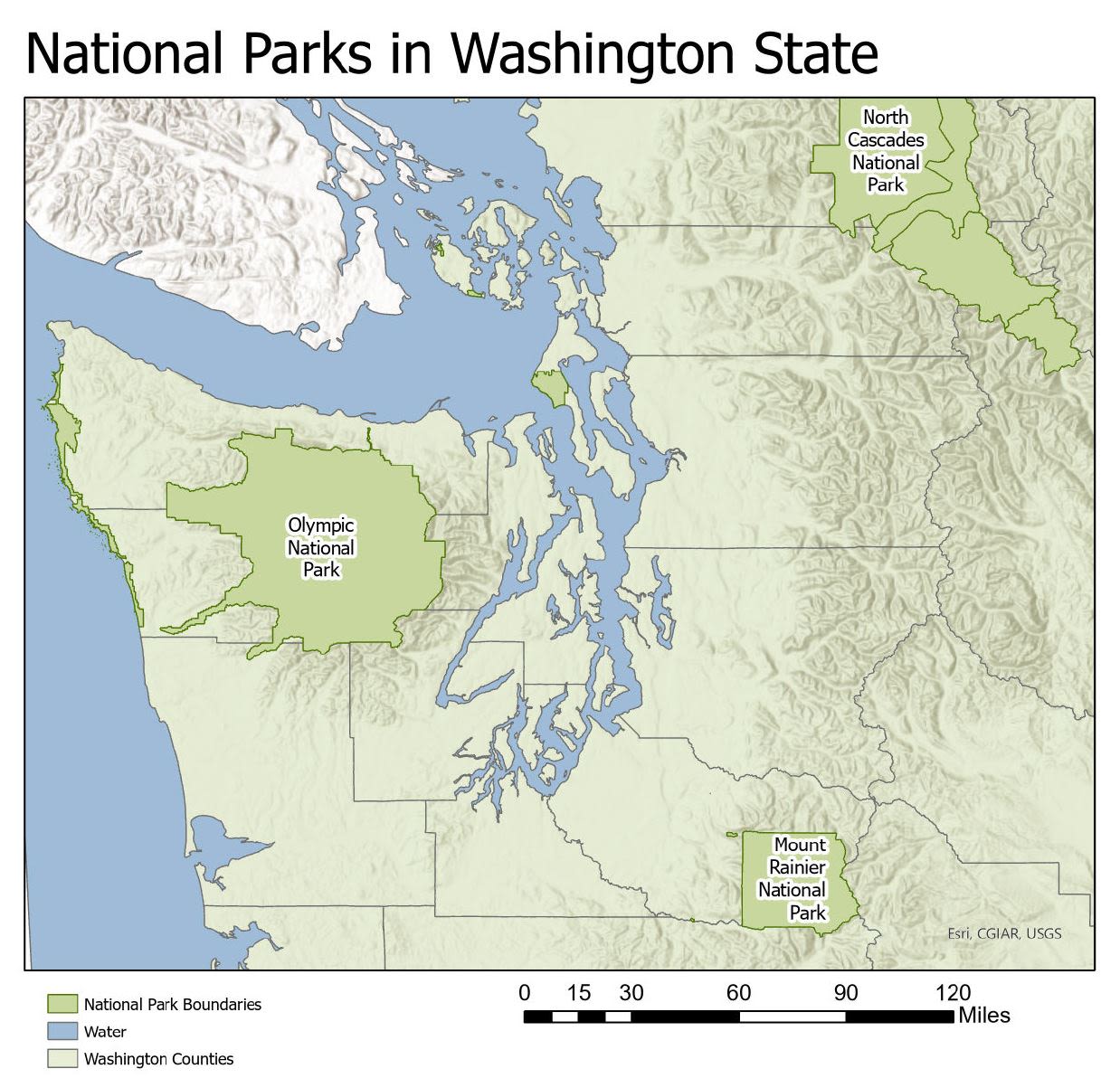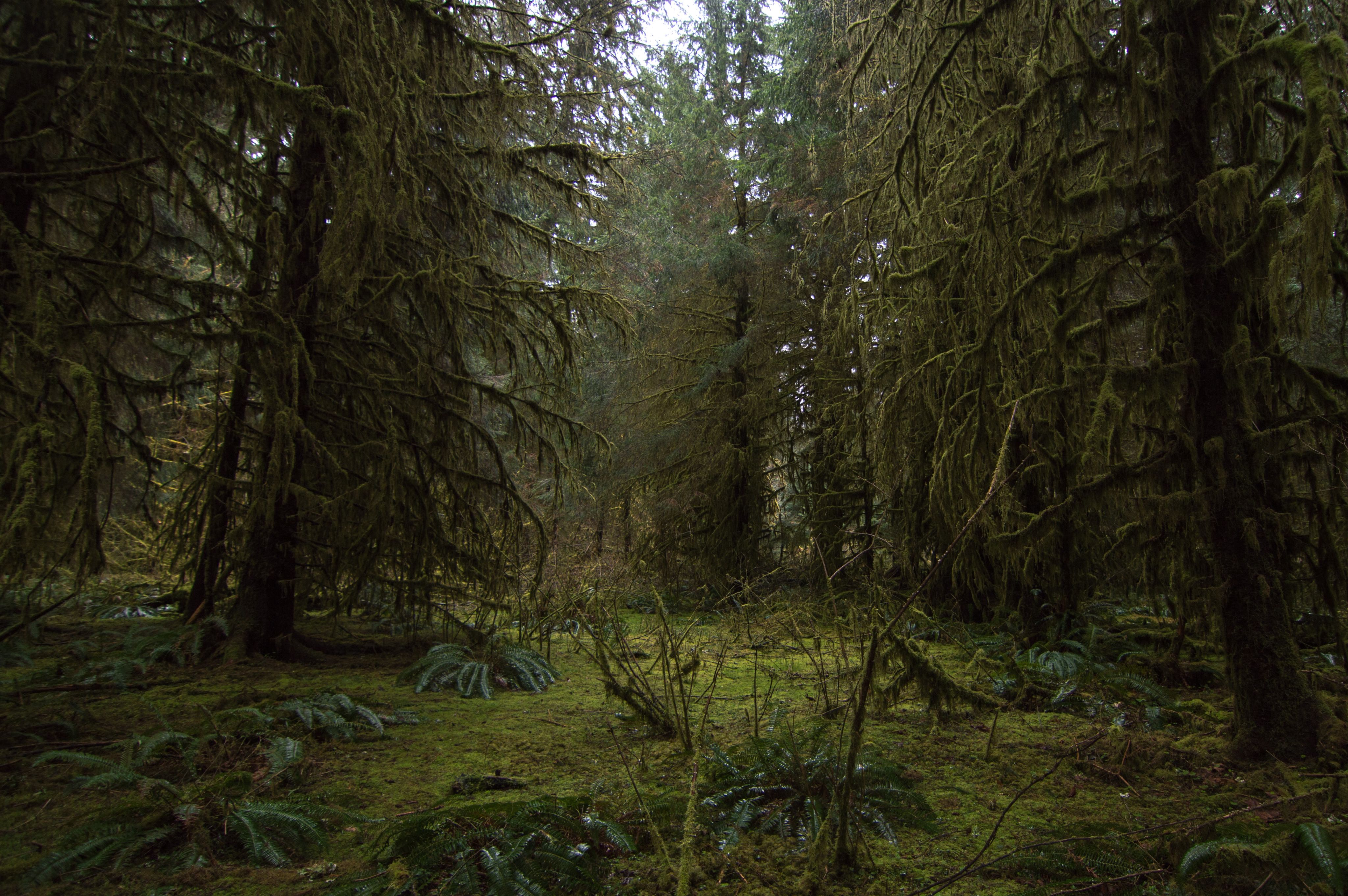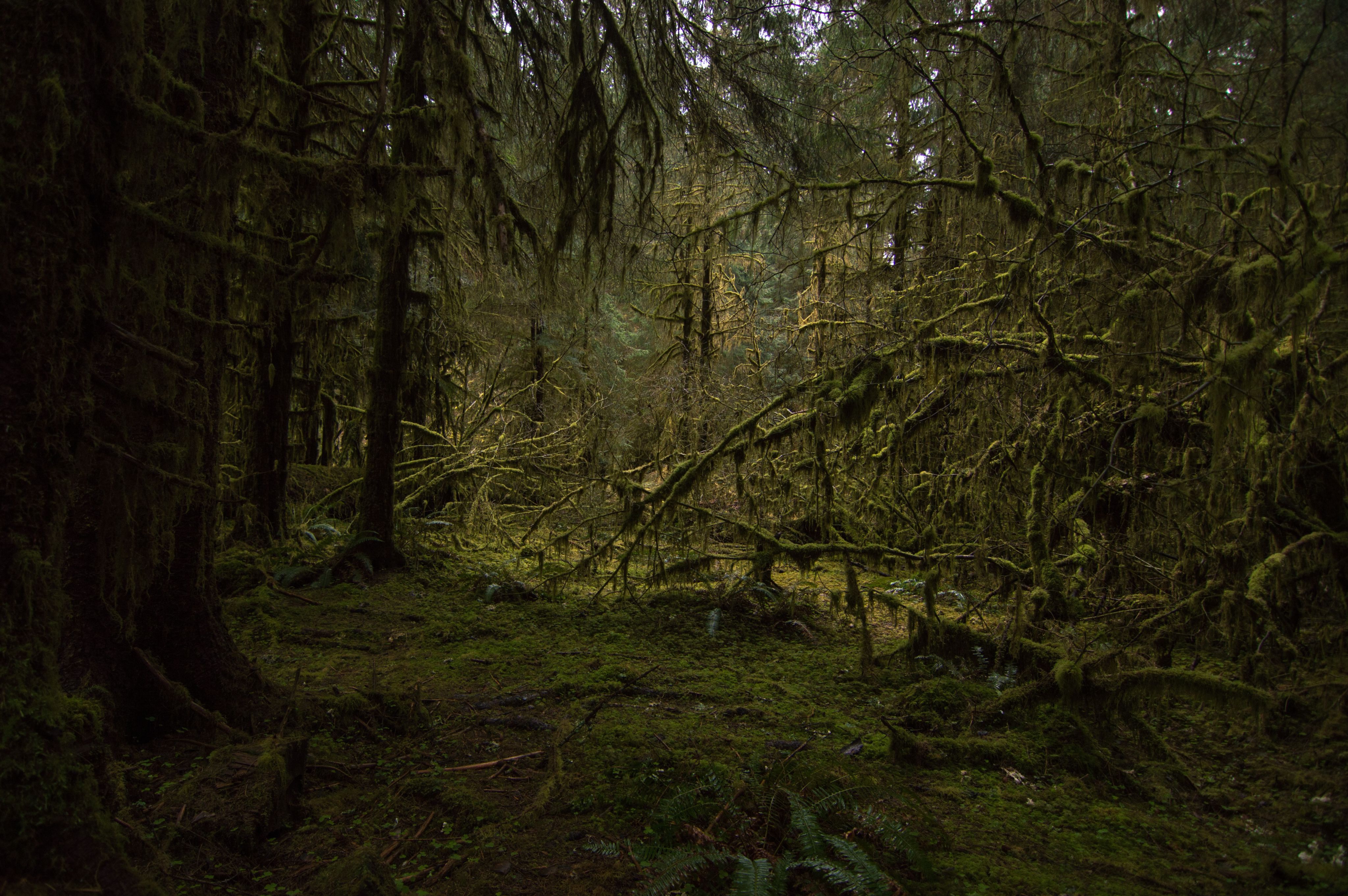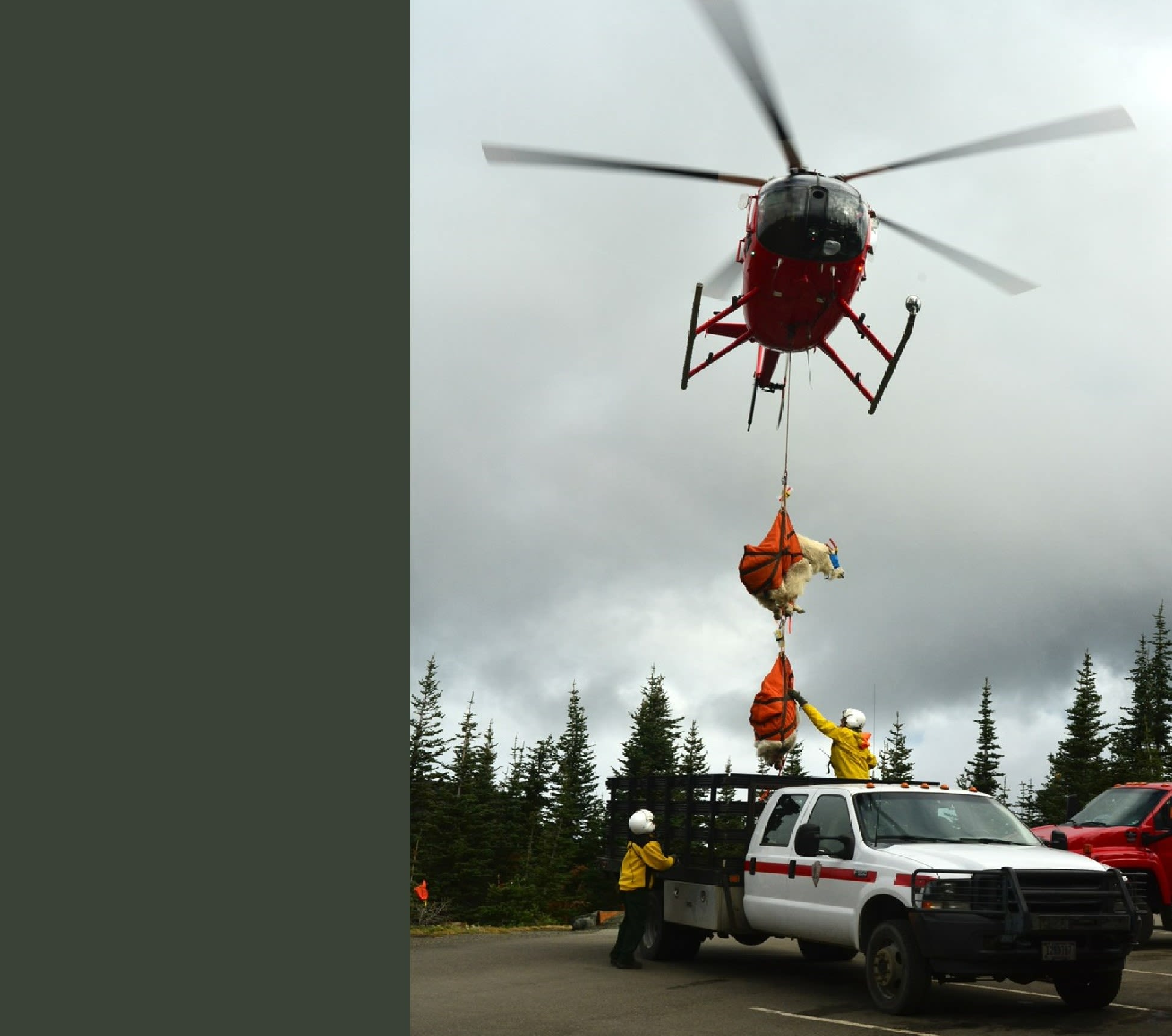The G.O.A.T of All Management Strategies
A case study of mountain goats in Olympic National Park

Olympic National Park, located on the Olympic Peninsula in Washington State, is nearly a million acres of wilderness. It consists of a variety of different ecosystems, including mountains, coastlines and some of the only remaining temperate rainforest in North America.
One species not historically found here, but found in most other mountain ranges throughout Washington State, is the North American mountain goat. First introduced in the years 1912-1925, this non-native species has found a home in the mountains of the Olympic Peninsula.
Washington State's National Parks
Located in the Northwest corner of the country, Washington State contains multiple beautiful national parks, each with their own distinct characteristics.

This map demonstrates the various national parks found in Washington State, including Olympic National Park. As can be seen, the region consists of several mountain ranges divided by ocean inlets known as the Puget Sound. This uniquely divided geography means that the ecosystem in Olympic National Park evolved somewhat separately from those in the mountains towards the east, which are known as the Cascade range.
Due to their geography, the Cascades have wetter, temperate rainforests on the west side of the mountain range, and a drier ponderosa pine forest on the east side. This feature, combined with the high variation in elevation means that the Cascades are home to a wide variety of animal species. This includes 75 mammal species such as the gray wolf, lynx, black bear, marmots and mountain goats.
The Olympic National Park also consists of several ecosystems unique to the region. These include mountain ranges, old growth temperate rainforests and rugged coastline along the Pacific Ocean. It is also home to a variety of animal species. These include the Olympic marmot, Olympic snow mole and Olympic torrent salamander. The area is also unique due to the species which do not occur in the region, but are found in nearby mountain ranges. Such species include pika, lynx, red foxes, coyotes, wolverines, grizzly bears and bighorn sheep.

Goat population in 1925


Non-Native Goat Population Continues to Grow
After the initial twelve goats were released into Olympic National Park in the early 1900s, their population grew. The habitat and terrain within the park is similar enough to that of the Cascade mountains, which allowed the goats to thrive. Since their introduction, the goats have colonized the park, which has presented ecological concerns.
The map below demonstrates the population estimates made of the mountain goats between 2011 and 2016 by the United States Geological Survey (USGS).
Estimates of Mountain Goat Populations in Washington State (2016)

Projected Increases in Population
Recognizing the problem with a growing goat population, researchers have been estimating the goat population every 3-7 years help track and manage the population. By maintaining close estimates of the population, wildlife managers are able to assess which management strategies work better than others. Additionally, by comparing counts across years, researchers were able to estimate a population growth rate.
Without intervention, the Olympic Park mountain goat population is expected to grow at a rate of 8% each year.
Due to the projected population increases, park managers recognized the need for action against the goat population. Goats negatively impact sensitive plant communities at the park. They also cause soil erosion by traveling throughout the park in groups. Finally, their presence in the parks means that they are encroaching on the habitat of other species that are native to the forest.
Goats Engage with Humans Too Frequently
As can be seen in the graphic to the left, unfavorable human-goat interactions occur more often than not in the park. Goats need salts to survive, which is something that they are able to find in their native ranges in the Cascade mountains. However, there are no natural occurring sources of salt in Olympic National Park, which means the goats must actively seek these out, often near places where humans frequent.
The frequency of human-goat interactions has persisted over the years, with one visitor even fatally gored by a goat in 2010. These dangers, combined with the negative effects on the plant community led to the need to take action to reduce the goat population.
Luckily for the mountain goats residing in the Olympic National Park, the Cascade mountain range is located less than 200 miles away.
The mountain goats in the Cascades are native to the area, and pose no potential harm to the ecosystem. Additionally, populations in the Cascades have been depleted over the years, making this an ideal spot for relocation.
Plan to Relocate the Goats to the Cascade Mountains
In 2016, the National Park Service began to develop a plan to transfer the goats away from the park. This involved researching the number and locations of most goats in the park, as well as creating an Environmental Impact Statement (EIS) to assess the impact of various alternative removal strategies.
The proposed alternatives included:
- Alternative A: No Action
- Alternative B: Capture and Translocation
- Alternative C: Lethal Removal
- Alternative D: Combination of Capture, Translocation and Lethal Removal
These alternatives were assessed in relation to various objectives outlined by park managers and other stakeholders in the area, including tribal governments and the US Forest Service. When compared against each objective, researchers concluded that Alternative D, a combination of capture, translocation and lethal removal of the goats provided the best approach to managing the goat population. The impact of each alternative on the proposed objectives can be seen in the graphic below.

Outcomes of Translocating the Goats
Once the appropriate alternative was chosen and approved, park managers implemented it over the course of four summers. This involved capturing the goats in very remote areas, and transferring them via helicopter to trucks that would then take them to the Cascade mountain range.
Ultimately, the program was successful in removing a total of 525 goats from the park.
Given that the population estimates of goats in 2018 was 729 individuals, this program was successful in removing 72% of all non-native goats in the park. Park staff targeted areas where there were high numbers of human visitors, as well as areas in the park where the goats were known to cause resource damage.
Park officials continue to strategize what to do with the goats that remain in the park, however it is likely that they will move forward with lethal removal methods. As the catch and translocation strategy progressed, the remaining goats became increasingly harder to catch. As noted on the project webpage, by the fourth round of capture in 2020, the capture mortality increased from 5.2% to 9.1%. This suggests that the goats are becoming more difficult to deal with, and it may not be efficient to continue to try to capture them.
Overall, this project was deemed to be a successful example of strategic wildlife management for the National Park Service. The goats were successfully removed from an environment that was not ideal for their species, and that was being negatively harmed due to their influence. Additionally, a large percentage of the goats were sent to live in the nearby Cascade mountain range, an area that had seen its native goat population depleted in recent years.
Image Source: Burger, J. (2021). Captured mountain goats from Olympic National Park [Photograph]. U.S. National Park Service. https://www.nps.gov/olym/planyourvisit/mountain-goat-capture-and-translocation.htm


How to Engage Further
Whether you are a casual enjoyer of nature, a conservation professional, or somewhere in between, there are a variety of ways to benefit from the lessons learned in this case study.
I am a Member of the Public
If you are a curious individual, student, hiking enthusiast, or otherwise interested in natural resource conservation, check out the links below.
I am a Wildlife Management Professional
If you are considering incorporating best practices or lessons learned from this project into your own planning strategies, check out the links below.
Sources:
Animals—Olympic National Park (U.S. National Park Service). (n.d.). National Park Service. Retrieved February 25, 2023, from https://www.nps.gov/olym/learn/nature/animals.htm
Final Mountain Goat Management Plan / Environmental Impact Statement. (2018). US Department of the Interior National Park Service. https://parkplanning.nps.gov/document.cfm?parkID=329&projectID=49246&documentID=87542
Jenkins, K., Beirne, K., Happe, P., Hoffman, R., Rice, C., & Schaberl, J. (2011). Seasonal Distribution and Aerial Surveys of Mountain Goats in Mount Rainier, North Cascades, and Olympic National Parks, Washington. U.S. Department of the Interior U.S. Geological Survey. https://pubs.usgs.gov/of/2011/1107/pdf/ofr20111107.pdf
Jenkins, K., Happe, P., Beirne, K., & Baccus, W. (2016). Mountain Goat Abundance and Population Trends in the Olympic Mountains, Northwestern Washington, 2016. U.S. Geological Survey. https://pubs.usgs.gov/of/2016/1185/ofr20161185.pdf
Mammals—North Cascades National Park (U.S. National Park Service). (2022, October 12). National Park Service. Retrieved February 25, 2023, from https://www.nps.gov/noca/learn/nature/mammals.htm
Mountain Goat Capture and Translocation—Olympic National Park. (2022, July 5). National Park Service. https://www.nps.gov/olym/planyourvisit/mountain-goat-capture-and-translocation.htm
Mountain goat (Oreamnos americanus). (n.d.). Washington Department of Fish & Wildlife. Retrieved February 26, 2023, from https://wdfw.wa.gov/species-habitats/species/oreamnos-americanus
Nature—North Cascades National Park (U.S. National Park Service). (2017, January 5). National Park Service. Retrieved February 25, 2023, from https://www.nps.gov/noca/learn/nature/index.htm
Olympic National Park (U.S. National Park Service). (2022, November 9). National Park Service. Retrieved February 25, 2023, from https://www.nps.gov/olym/index.htm
Image Sources:
Burger, J. (2021). Captured mountain goats from Olympic National Park [Photograph]. U.S. National Park Service. https://www.nps.gov/olym/planyourvisit/mountain-goat-capture-and-translocation.htm
